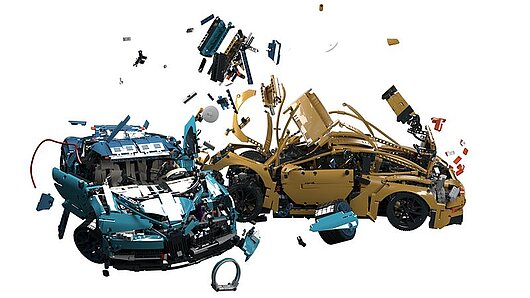High-Performance Computing Center Stuttgart

The experiment is covered in a two-part feature article appearing in c't Magazin für Computer Technik. Although the experiment was conducted with toy cars, the scientists' approaches are similar to those used in developing virtual crash tests for automobiles — an increasingly important phase of car development. The articles and video included in the reportage thus provide a useful overview of how virtual crash tests are carried out.
See the coverage of the LEGO Test Crash in c't (in German): Overview / Part 1 / Part 2
The scientists created extremely high-resolution digital models of two LEGO cars — a Porsche and a Bugatti — in which every LEGO block is composed of thousands of reference points. In total, the model of the two vehicles comprised approximately 45 million finite elements, which is approximately the same number used in developing crash test models for real automobiles. To create the model, these data are then combined with a mathematical framework that describes the physical stresses at work on the vehicles during a crash.
Running a simulation that involves tracking so many variables across the time span involved in a crash would be impossible without high-performance computing. Running on HLRS's Hazel Hen supercomputer, the c't article reports, the simulation took a full week using approximately 1000 cores.
Once the simulation was complete, specialists in the HLRS Visualization Department used software developed at HLRS, called Vistle, to help the DYNAmore scientists produce a detailed visualization of the crash. Wearing 3D glasses in the HLRS CAVE, they could then stand in the middle of a virtual crash scene and observe in slow motion the model's prediction of how the LEGO blocks would fly apart.
To test the accuracy of their model, the DYNAmore scientists then brought two real LEGO cars to an ADAC (German Automobile Club) crash test facility normally used for certifying full-size cars. The toy Porsche was accelerated down a track at 46 km/h when it slammed into the side of the Bugatti. The collision was videotaped using high-speed cameras so that the real-world motions of the LEGO blocks following impact could be compared to what the virtual reality version of the crash predicted.
Following the collision the scientists reviewed the accuracy of their model. In many respects they noticed correspondence between model and reality, although the degree of destruction in the actual crash was higher than expected.
Because the temperature was unusually warm on the day of the physical crash test, the scientists believe that the discrepancy might in part be due to differences in the material properties of the LEGO blocks under different temperature conditions — a feature that was not accounted for in the model. The reporting in c't indicates that the scientists will use this gained knowledge to optimize their model further, a step that also reflects a growing interest in integrating more complex material models of components into virtual crash models in the auto industry.
—Christopher Williams